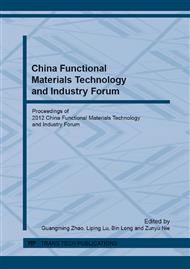p.456
p.460
p.465
p.473
p.478
p.483
p.488
p.495
p.505
Synthesis and Characterization of Alkyl Bacterial Cellulose through Etherification with Alkyl Bromide in DMAc/LiCl
Abstract:
Four types of alkyl (ethyl, propyl, isopropyl, n-butyl) bacterial cellulose with the degree of substitution 0.14-2.64 were prepared through etherification of bacterial cellulose with alkyl bromide in dimethyl acetamide/lithium chloride solution under ambient pressure at 50°C, with sodium hydride as the acid binding agent. The products were characterized through FTIR, NMR, and elemental analysis. The solubility of the derivatives in chloroform, ethanol, DMSO, and toluene/ethanol (V/V 3/7) was tested. Key words: alkyl bacterial cellulose, alkyl bromide, synthesis, characterization
Info:
Periodical:
Pages:
478-482
Citation:
Online since:
May 2013
Authors:
Keywords:
Price:
Сopyright:
© 2013 Trans Tech Publications Ltd. All Rights Reserved
Share:
Citation:


